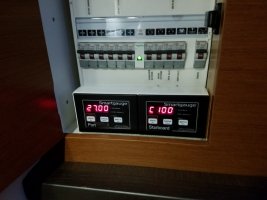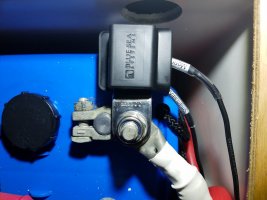I reached out to Victron yesterday with a few questions, and they came back with answers this morning (they were actually super-responsive).
I asked if the Victron BMV-702 can monitor SOC on two separate batteries/banks. They said NO - the 702 "can fully monitor one bank and provide voltage on a second".
That's... the same as the SmartGuage.
They said if I wanted to fully monitor two banks, "a second BMV would be needed to measure capacity."
But then said that the best use of a battery monitor is on the "start" bank, that most people find simple voltage is adequate on the "house" bank. This is consistent with the guidance in PM from a friend-I've-never-met, who said that "putting money into a meter for the reserve battery doesn't make a lot of sense".
So... that's where I'm going to leave it. I have a monitor on the start bank, I have voltage on the house bank, I'm good with that.
Interestingly, both people stressed the importance of "synchronizing" the Victron regularly... which is something I have not thought about doing. It's how the errors in the coulomb-counter type of system are factored out to ensure that the SOC measurement stays, well, in sync with the capacity of the battery. I'll be doing some reading up on this, and buying a load-tester.
The Victron guy said "If the BMV is synchronized often (every couple weeks) it’s quite accurate. This will require a full charge of the batteries which is needed anyway for the battery to have a normal lifespan. Battery aging is almost impossible to measure/guess by voltage, so discharging the battery during the course of hours and measuring how much energy it is able to provide is the only way to measure remaining capacity. The BMV is an excellent tool for measuring battery capacity over a discharge period with a controlled load. "
That actually makes sense to me. And hope it's useful here...
_/)_
Bruce
I asked if the Victron BMV-702 can monitor SOC on two separate batteries/banks. They said NO - the 702 "can fully monitor one bank and provide voltage on a second".
That's... the same as the SmartGuage.
They said if I wanted to fully monitor two banks, "a second BMV would be needed to measure capacity."
But then said that the best use of a battery monitor is on the "start" bank, that most people find simple voltage is adequate on the "house" bank. This is consistent with the guidance in PM from a friend-I've-never-met, who said that "putting money into a meter for the reserve battery doesn't make a lot of sense".
So... that's where I'm going to leave it. I have a monitor on the start bank, I have voltage on the house bank, I'm good with that.
Interestingly, both people stressed the importance of "synchronizing" the Victron regularly... which is something I have not thought about doing. It's how the errors in the coulomb-counter type of system are factored out to ensure that the SOC measurement stays, well, in sync with the capacity of the battery. I'll be doing some reading up on this, and buying a load-tester.
The Victron guy said "If the BMV is synchronized often (every couple weeks) it’s quite accurate. This will require a full charge of the batteries which is needed anyway for the battery to have a normal lifespan. Battery aging is almost impossible to measure/guess by voltage, so discharging the battery during the course of hours and measuring how much energy it is able to provide is the only way to measure remaining capacity. The BMV is an excellent tool for measuring battery capacity over a discharge period with a controlled load. "
That actually makes sense to me. And hope it's useful here...
_/)_
Bruce


